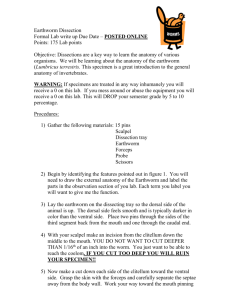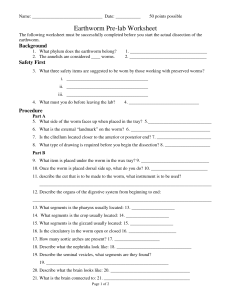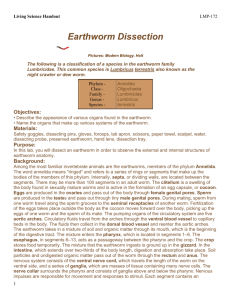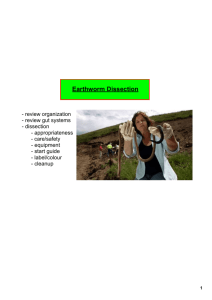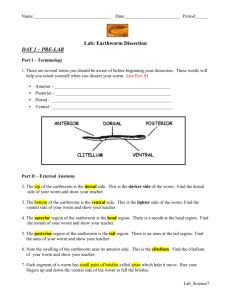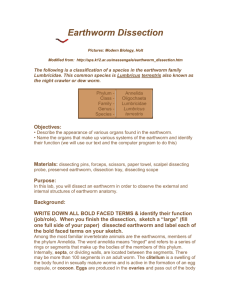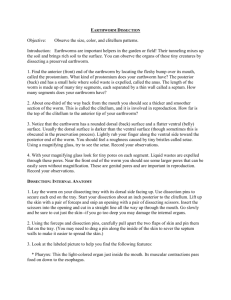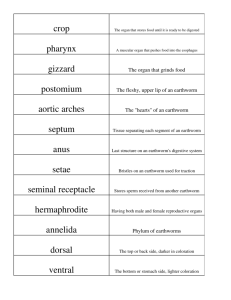BIOLOGY
advertisement
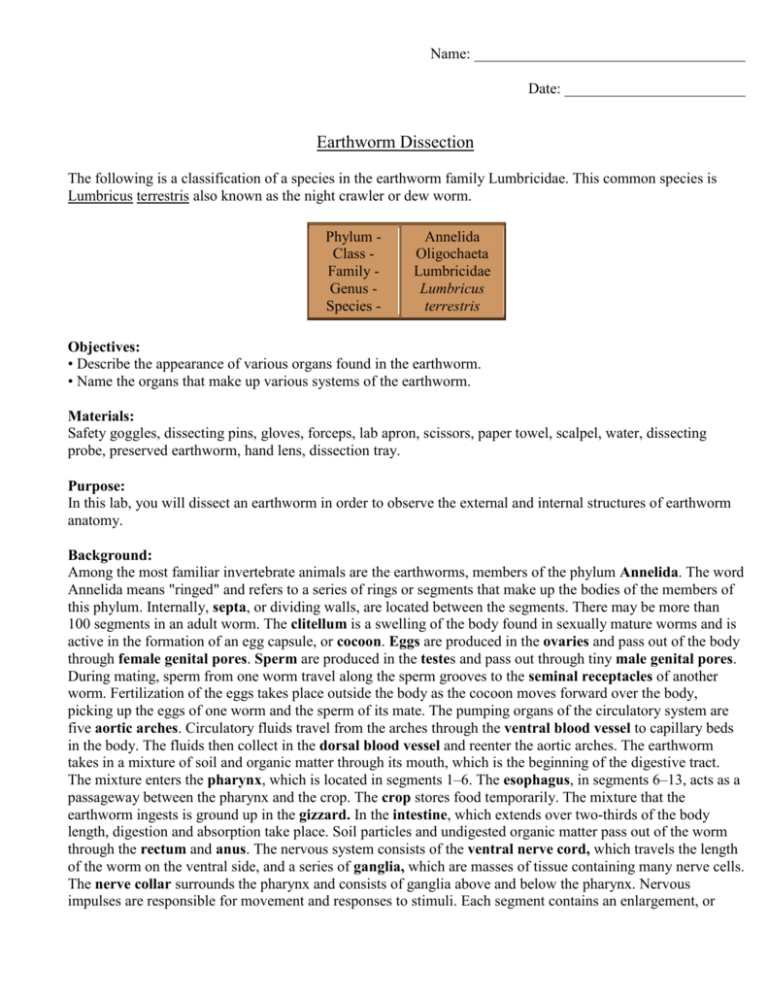
Name: ____________________________________ Date: ________________________ Earthworm Dissection The following is a classification of a species in the earthworm family Lumbricidae. This common species is Lumbricus terrestris also known as the night crawler or dew worm. Phylum Class Family Genus Species - Annelida Oligochaeta Lumbricidae Lumbricus terrestris Objectives: • Describe the appearance of various organs found in the earthworm. • Name the organs that make up various systems of the earthworm. Materials: Safety goggles, dissecting pins, gloves, forceps, lab apron, scissors, paper towel, scalpel, water, dissecting probe, preserved earthworm, hand lens, dissection tray. Purpose: In this lab, you will dissect an earthworm in order to observe the external and internal structures of earthworm anatomy. Background: Among the most familiar invertebrate animals are the earthworms, members of the phylum Annelida. The word Annelida means "ringed" and refers to a series of rings or segments that make up the bodies of the members of this phylum. Internally, septa, or dividing walls, are located between the segments. There may be more than 100 segments in an adult worm. The clitellum is a swelling of the body found in sexually mature worms and is active in the formation of an egg capsule, or cocoon. Eggs are produced in the ovaries and pass out of the body through female genital pores. Sperm are produced in the testes and pass out through tiny male genital pores. During mating, sperm from one worm travel along the sperm grooves to the seminal receptacles of another worm. Fertilization of the eggs takes place outside the body as the cocoon moves forward over the body, picking up the eggs of one worm and the sperm of its mate. The pumping organs of the circulatory system are five aortic arches. Circulatory fluids travel from the arches through the ventral blood vessel to capillary beds in the body. The fluids then collect in the dorsal blood vessel and reenter the aortic arches. The earthworm takes in a mixture of soil and organic matter through its mouth, which is the beginning of the digestive tract. The mixture enters the pharynx, which is located in segments 1–6. The esophagus, in segments 6–13, acts as a passageway between the pharynx and the crop. The crop stores food temporarily. The mixture that the earthworm ingests is ground up in the gizzard. In the intestine, which extends over two-thirds of the body length, digestion and absorption take place. Soil particles and undigested organic matter pass out of the worm through the rectum and anus. The nervous system consists of the ventral nerve cord, which travels the length of the worm on the ventral side, and a series of ganglia, which are masses of tissue containing many nerve cells. The nerve collar surrounds the pharynx and consists of ganglia above and below the pharynx. Nervous impulses are responsible for movement and responses to stimuli. Each segment contains an enlargement, or ganglion, along the ventral nerve cord. Excretory functions are carried on by nephridia, which are found in pairs in each body segment. They appear as tiny white fibers on the dorsal body wall. The earthworm has no gills or lungs. Gases are exchanged between the circulatory system and the environment through the moist skin. Procedure: 1. Put on safety goggles and gloves. 2. Place earthworm in the dissecting tray & rinse off the excess preservative. Identify the dorsal side, which is the worm’s rounded top, and the ventral side, which is its flattened bottom. Turn the worm ventral side up, as shown in the diagram below. 3. Find the anterior end by locating the prostomium, which is a fleshy lobe that extends over the mouth. The other end of the worm’s body is the posterior end, where the anus is located. 4. Locate the clitellum, which extends from segment 33 to segment 37. Look for the worm’s setae, which are the minute bristle-like spines located on every segment except the first and last one. 5. Refer again to the diagram of the ventral view of the worm to locate and identify the external parts of its reproductive system. Find the pair of sperm grooves that extend from the clitellum to about segment 15, where one pair of male genital pores is located. Look also for one pair of female genital pores on segment 14. There is another pair of male genital pores on about segment 26. Try to find the two pairs of openings of the seminal receptacles on segment 10. Note: These openings are not easy to see. 6. Turn the worm dorsal side up. Using a scalpel and scissors, make a shallow incision in the dorsal side of the clitellum at segment 33. CAUTION: Scalpels and scissors are very sharp. Report any cuts to your teacher. Using the forceps and scalpel, spread the incision open, little by little. Separate each septum from the central tube using a dissecting needle, and pin down each loosened bit of skin. Continue the incision forward to segment 1. 7. Use the diagram below to locate and identify the five pairs of aortic arches, or hearts. Then find the dorsal blood vessel. Look for smaller blood vessels that branch from the dorsal blood vessel. 8. Locate the digestive tract, which lies below the dorsal blood vessel. Refer to the diagram above to locate the pharynx, esophagus, crop, gizzard, and intestine. 9. To find organs of the nervous system, push aside the digestive and circulatory system organs. Use the diagram below to locate the ventral nerve cord. Trace the nerve cord forward to the nerve collar, which circles the pharynx. Find one pair of ganglia under the pharynx and another pair of ganglia above the pharynx. The ganglia above the pharynx serve as the brain of the earthworm. 10. The worm’s excretory organs are tiny nephridia. There are two in every segment. Use the preceding diagram to locate some nephridia. 11. Use the diagram below to locate and identify a pair of ovaries in segment 13. Look for two pairs of tiny testes in segments 10 and 11. To find these organs, you will again have to push aside some parts already dissected. 12. Dispose of your materials according to the directions from your teacher. 13. Clean up your work area and wash your hands before leaving the lab. Name: ____________________________________ Date: ___________________________ Earthworm Worksheet 1. What is the name of the pumping organs of an earthworm? 2. Trace the parts of the digestive tract through which food passes. 3. Which parts of the earthworm serve as its brain? How are these parts connected to the rest of the body? 4. Which of the parts of the worm’s body that you saw are included in the excretory system? 5. How can you find out whether an earthworm eats soil? 6. Among the earthworm’s structural adaptations are its setae. How do you think the earthworm’s setae make it well adapted to its habitat? 7. How is the earthworm’s digestive system adapted for extracting relatively small amounts of food from large amounts of ingested soil? 8. Your dissection of the earthworm did not go beyond segment 32.What will you observe if you dissect the remainder of the worm to its posterior end? As you work through the Earthworm Dissection Lab, fill in the structures of the following functions: STRUCTURE FUNCTION Opening to release digestive wastes Concentration of nerve tissue, connected to the ventral nerve cord ‘hearts’, pump blood Used during mating, produces a slime ring that moves anteriorly picking up eggs and sperm, becomes the cocoon for the developing young Storage area for food Carries blood along top of body Connecting tube between the pharynx and the crop, the aortic arches wrap around this structure Grinds the food before passing it to the intestine Digestion and absorption of food Opening at the anterior end, food enters here as the earthworm burrows through the soil Primitive “kidney-like” structures in each segment to absorb and secrete wastes Female reproductive organs, produce eggs Muscular structure to pull in soil with the food for the worm First anterior segment, also called the upper lip Storage area for sperm that is received from another worm Aid in movement of the worm through the soil Male reproductive organs produce sperm, the sperm from one worm is always transferred to a different worm Returns blood to the aortic arches along the ventral side of the worm Attached to the brain, this nerve sends and receives messages, aiding in the coordination of movement
